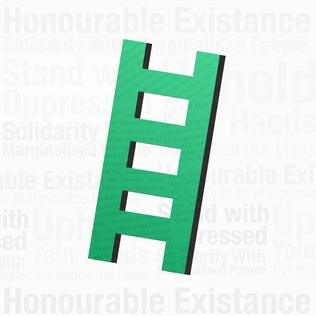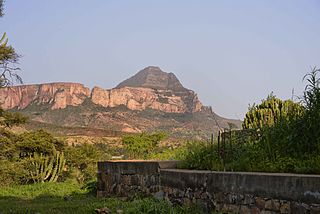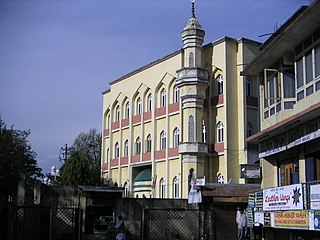
The Umayyad Caliphate or Umayyad Empire was the second caliphate established after the death of the Islamic prophet Muhammad and was ruled by the Umayyad dynasty. Uthman ibn Affan, the third of the Rashidun caliphs, was also a member of the clan. The family established dynastic, hereditary rule with Mu'awiya I, the long-time governor of Greater Syria, who became caliph after the end of the First Fitna in 661. After Mu'awiya's death in 680, conflicts over the succession resulted in the Second Fitna, and power eventually fell to Marwan I, from another branch of the clan. Syria remained the Umayyads' main power base thereafter, with Damascus as their capital.

Indian Union Muslim League is a political party primarily based in Kerala. It is recognised as a State Party in Kerala by the Election Commission of India.

Islam is one of the smallest minority faiths in Belize, which is a predominantly Christian country. The statistics for Islam in Belize estimate a total Muslim population of 577, representing 0.2 percent of the total population. There is an Islamic Mission of Belize (IMB) headquartered in Belize City. There is also presence of fast growing dynamic worldwide Ahmadiyya Muslim Jamaat since 2013. They have a membership of about 200 from all over Belize.They have three mosques in Belize. Masjid Noor in Belize City is situated on 1.5 Miles George Price Highway. They have mosques in Belmopan and Orange Walk.. The Muslim Community Primary School (MCPS) was recognised by the government in 1978 and offers Islamic as well as elementary level academic courses to Muslim and non-Muslim children.

The statistics for Islam in Antigua and Barbuda estimate a total Muslim population of about 200, representing 0.3 percent of the total population of 67,448. Most of the Muslims of the islands are Arabs of Syrian or Lebanese descent. There are two known Islamic organizations in St. John's, including the Antigua and Barbuda International Islamic Society and the American University of Antigua Muslim Students Association. There is also an Ahmadiyya mission in Antigua. Outside St. John's, there is the Muslim Community of Antigua and Barbuda in Codrington, Barbuda. A Pew Research Center survey in 2016 calculated the total number to be around 950.

Dominica is an overwhelmingly Christian majority country, with adherents of Islam being a minuscule minority. Due to secular nature of the Dominica's constitution, Muslims are free to proselytize and build places of worship in the country.

The latest statistics for Islam in Paraguay estimate a total Muslim population of under 1,000 representing 0.02% of the population. But, another estimate puts the number of Muslim members in Paraguay at 35,000 people. Most of the Muslims are descendants of immigrants from Syria and Lebanon. The major Islamic organization in Paraguay is the Centro Benéfico Cultural Islámico Asunción, led by Faozi Mohamed Omairi. The community is concentrated in and around the capital, Asuncion.

Uruguay is a Christian majority country, with Islam being a minority religion. Due to the secular nature of Uruguay's constitution, Muslims are free to proselytize and build places of worship in the country.

Islam is an Abrahamic monotheistic religion centered on the Quran and the teachings of Muhammad, the religion's founder. Adherents of Islam are called Muslims, who are estimated to number approximately 1.9 billion worldwide and are the world's second-largest religious population after Christians.
Ali Sadreddine Al-Bayanouni is a Muslim Brotherhood leader in exile in London. He was born in 1938 in Aleppo and brought up in a religious family, where his father and grandfather were both well known Muslim scholars. He joined the Muslim Brotherhood while in secondary school, in 1954, and went on to graduate with a law degree from the University of Damascus in 1963. He served as a reserve officer in the Syrian Army from 1959 to 1960. Bayanouni became a member of the Syrian Muslim Brotherhood's Shura Council and Executive Office in 1972. Due to his membership in the Muslim Brotherhood, Bayanouni was imprisoned from 1975 to 1977. After his time in prison, he emerged to become the deputy leader of the Brotherhood in 1977. He left Syria two years later and eventually settled in Jordan, where he remained for twenty years. He arrived in Britain as a political refugee in 2000, after the Jordanian authorities requested he leaves the country.

Gulomakeda is one of the Districts of Ethiopia, or woredas, in the Tigray Region of Ethiopia. Its name partly comes from the legendary Queen Makeda, also known as the Queen of Sheba. Part of the Misraqawi Zone, Gulomakeda is bordered on the south by Ganta Afeshum, on the west by the Mehakelegnaw (Central) Zone, on the north by Eritrea, on the east by Irob, and on the southeast by Saesi Tsaedaemba. Towns in Gulomakeda include Fatsi, Sebeya and Zalambessa. Gulomakeda has many historical places like Debredamo. Wereda Gulomakeda has 2 preparatory schools Yemane senior secondary school and Zalambessa senior secondary school. Notable local landmarks in this woreda include ruins that have been dated to the Axumite Kingdom, as well as to the period prior to its rise. Archeological surveys conducted by Dr. Catherine D'Andrea of Simon Fraser University show that far from being a rural hinterland, Gulomakeda had large towns with elite groups who had access to exotic trade goods during that time. She also identified cultural links to ancient Eritrean settlements, which included Matara and the ancient Ona culture.

Saesi Tsaedaemba is one of woredas in the Tigray Region of Ethiopia. Located in the Misraqawi Zone at the eastern edge of the Ethiopian highlands, Saesi Tsaedaemba is bordered on the south by Kilte Awulaelo, on the southwest by Hawzen, on the west by Ganta Afeshum, on the northwest by Gulomahda, on the north by Irob, on the east by the Afar Region, and on the southeast by Atsbi Wenberta. Towns in Saesi Tsaedaemba include Edaga Hamus and Freweyni also known as Sinkata) where the woreda office is located.

Ganta Afeshum is one of the woredas in the Tigray Region of Ethiopia. Part of the Misraqawi Zone, Ganta Afeshum is bordered on the south by Hawzen, on the west by the Mehakelegnaw (Central) Zone, on the north by Gulomahda, and on the east by Saesi Tsaedaemba. Towns in Ganta Afeshum include Bizet. Since the town of Adigrat split off Ganta Afeshum as a separate woreda, it is surrounded by this woreda.

Kilte Awulaelo is one of woredas in the Tigray Region of Ethiopia. Part of the Misraqawi Zone, Kilte Awulaelo is bordered on the south by the Debub Misraqawi (Southeastern) Zone, on the west by the Mehakelegnaw (Central) Zone, on the northeast by Hawzen, on the north by Saesi Tsaedaemba, and on the east by Atsbi Wenberta. Towns in the Kilte Awulaelo woreda include Agula, Tsigereda and Maimekden. Town of Wukro is surrounded by Kilte Awulaelo.

Grenada is an overwhelmingly secular but Christian majority country, with adherents of Islam being minority. Due to secular nature of the Grenada's constitution, Muslims are free to proselytize and build places of worship in the country. There are over 1,500 Muslims in Grenada. They make up 0.75% of the population.

The vast majority of the Moldovan people are Orthodox Christians, but there is a small community of Muslims in Moldova, numbering a few thousand.

Islam is the third largest religion in Nepal. According to the 2021 Nepal census, approximately 1.483 million Muslims, comprising 5.09% of the population, live in Nepal.

Tonga is an overwhelmingly Christian majority country, with adherents of Islam being a minuscule minority. Due to secular nature of the Tonga's constitution, Muslims are free to proselytize and build places of worship in the country. Most Muslims in Tonga belong to either Sunni or Ahmadiyya denominations. The number of Muslims was estimated at less than 1000 in 2010 by the Pew Research Center in a population of about 108,000, while a report by the Fiji Muslim League estimated that in 2002 there were about 70 Muslim Tongan nationals out of a Muslim population of 100.

Islam is a minority religion in French Guiana. The Islamic population is made up of mainly Arabs from Lebanon, and Afghan Muslims. In Cayenne, the capital of the region, and Kourou, there is an Islamic centre and a Muslim school. Majority of the Muslims belong to Sunni denomination. There are a few Ahmadi Muslims who established themselves in the region in the year 2007.

According to a 2009 Pew Research Center report, Muslims constitute approximately 0.1% of the population in Saint Lucia.
Cheetah Mehrat is an ethnic group in the state of Rajasthan, India. They are spread across Ajmer, Bhilwara, Pali, and Rajsamand districts of Rajasthan. The estimated population of Cheetah Mehrat is approximately one million people. The community is known for its harmonious coexistence between Hindus and Muslims. They practise both religions. Cheetah Mehrat is classified as an Other Backward Class.









